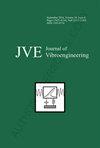不同斜度下斜交桥合理参数的确定
IF 0.9
Q4 ENGINEERING, MECHANICAL
引用次数: 0
摘要
利用OpenSees软件建立有限元模型进行时程分析,以典型的3×20 m斜度连续梁桥为例,分析斜度桥梁的地震反应规律及关键构件的损伤体积。研究了斜交连续梁桥在桥台伸缩缝尺寸、剪力键间距和剪力键强度等因素下的地震反应,并对支座、剪力键和桥墩的损伤率进行了评估。研究结果表明:在0.3 g PGA的地震地震动作用下,传递给桥墩的地震力较小,桥墩由于支座的滑动而具有弹性,但剪力键的破坏程度大于支座和桥墩的破坏程度。冲击增加了主梁在非锐角方向上的旋转效应,导致锐角处剪切键的损伤大于钝角处。随着伸缩缝的增大,轴承和剪切键的损伤先增大后减小,且斜倾角越大,伸缩缝对应的轴承和剪切键最大位移越小。随着剪力键间隙的增大,剪力键对主梁的变形限制作用显著减弱,导致支座滑移呈线性增加,增加了主梁沉降的风险。随着抗剪键强度的增大,轴承和抗剪键损伤先大幅减小,后略有增大。但桥墩损伤明显增大。在地震风险高的地区,建议将剪切键作为“保险丝元件”。对于任意斜角,可将剪切键间隙减小至2 cm,可将剪切键强度提高至125%或150%。当倾斜角度在30 ~ 60之间时,可将伸缩缝尺寸增加到12cm或16cm。本文章由计算机程序翻译,如有差异,请以英文原文为准。
Determination of reasonable parameters for skew bridge under different skew angles
A finite element model is created using OpenSees software to perform a time history analysis in order to analyze the seismic response law of a skew bridge and the damage volume of its key components, using a typical 3×20 m skew continuous girder bridge as an example. The seismic response of the skew continuous girder bridge under various factors such as the size of the abutment expansion joint, shear key gap, and shear key strength is studied then the damage rate is assessed for the bearing, shear key, and pier. The research results show that under the action of earthquake ground motion with 0.3 g PGA, the seismic force transmitted to the pier is small, and the pier is elastic owing to the sliding of the bearing, but the damage degree of the shear key is larger than that of the bearing and pier. The impact increases the rotation effect of the main beam in the direction of off acute angle, resulting in a greater damage to the shear key at the acute angle than that at the obtuse angle. The damage of bearing and shear key increases and then decreases with the increasing of expansion joint, and the larger the skew angle is, the smaller the expansion joint will be corresponding to the maximum displacement of bearing and shear key. With the increase of the shear key gap, the deformation limitation effect of the shear key on the main beam decreases significantly, resulting in a linear increase in the bearing slip, which increases the risk of the main beam subsidence. With the increase of the shear key strength, the bearing and shear key damage decreases greatly at first, and then increases slightly. However, the pier damage increases obviously. In an area with a high risk of earthquake, it is recommended that the shear key can be a “fuse element”. For any oblique angle, the shear key gap can be reduced to 2 cm, and the shear key strength can be increased to 125 % or 150 %. When the skew angle is between 30 and 60, the expansion joint size can be increased to 12 cm or 16 cm.
求助全文
通过发布文献求助,成功后即可免费获取论文全文。
去求助
来源期刊

Journal of Vibroengineering
工程技术-工程:机械
CiteScore
1.70
自引率
0.00%
发文量
97
审稿时长
4.5 months
期刊介绍:
Journal of VIBROENGINEERING (JVE) ISSN 1392-8716 is a prestigious peer reviewed International Journal specializing in theoretical and practical aspects of Vibration Engineering. It is indexed in ESCI and other major databases. Published every 1.5 months (8 times yearly), the journal attracts attention from the International Engineering Community.
 求助内容:
求助内容: 应助结果提醒方式:
应助结果提醒方式:


